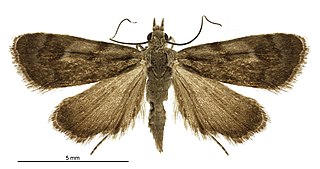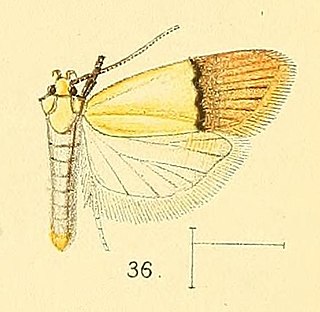
Pyraustinae is a large subfamily of the lepidopteran family Crambidae, the crambid snout moths. It currently includes about 1,280 species Most of them tropical but some found in temperate regions including both North America and Europe.

Crambinae is a large subfamily of the lepidopteran family Crambidae, the crambid snout moths. It currently includes over 1,800 species worldwide. The larvae are root feeders or stem borers, mostly on grasses. A few species are pests of sod grasses, maize, sugar cane, rice, and other Poaceae. The monophyly of this group is supported by the structure of the tympanal organs and the phallus attached medially to the juxta, as well as genetic analyses.

Ardozyga is a genus of moths in the family Gelechiidae.

Aristotelia is a genus of moths in the family Gelechiidae. Well-known species are food plant specialists, and diverse hosts are used – Salicaceae, Solanaceae, Rosaceae, Fagaceae, Fabaceae, Asteraceae.

Glaucocharis is a genus of moths of the family Crambidae first described by Edward Meyrick in 1938. The type species for this genus is Glaucocharis stella.

Lecithocera is a genus of moths in the lecithocerid subfamily Lecithocerinae. The genus was erected by Gottlieb August Wilhelm Herrich-Schäffer in 1853.

Labdia is a genus of moths in the family Cosmopterigidae.

Prochoreutis myllerana, Miller’s nettle-tap or small metal-mark, is a moth of the family Choreutidae found in Asia and Europe. Miller's nettle-tap was first described by Johan Christian Fabricius in 1794 from a specimen found in Sweden.

Prochoreutis is a genus of moths in the family Choreutidae.
Prochoreutis argyrastra is a species of moth of the family Choreutidae. It is found in Ethiopia.

Xyloryctidae is a family of moths contained within the superfamily Gelechioidea described by Edward Meyrick in 1890. Most genera are found in the Indo-Australian region. While many of these moths are tiny, some members of the family grow to a wingspan of up to 66 mm, making them giants among the micromoths.
Prochoreutis halimora is a moth in the family Choreutidae. It was described by Edward Meyrick in 1912. It is found in India (Assam) and Taiwan.
Prochoreutis hestiarcha is a moth in the family Choreutidae. It was described by Edward Meyrick in 1912. It is found in Assam in India and in China.

Odites is a genus of moths in the family Depressariidae. Most species of this genus are found in Asia and in Africa.

Gelechiinae is a subfamily of moths in the family Gelechiidae. It was described by Henry Tibbats Stainton in 1854.

Anomologinae is a subfamily of moths in the family Gelechiidae.

The Stenomatinae are a subfamily of small moths in the family Depressariidae.













